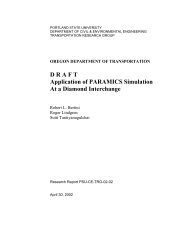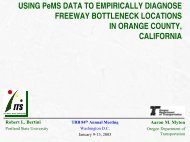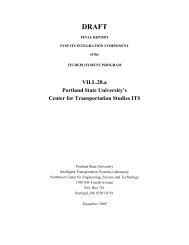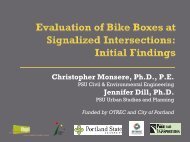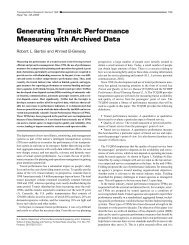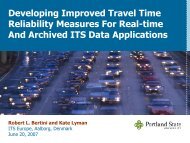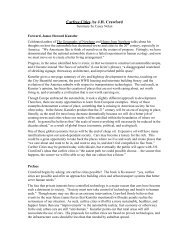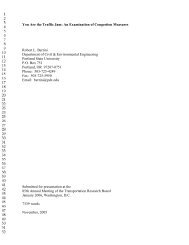Application of Paramics Simulation to a Diamond Interchange
Application of Paramics Simulation to a Diamond Interchange
Application of Paramics Simulation to a Diamond Interchange
You also want an ePaper? Increase the reach of your titles
YUMPU automatically turns print PDFs into web optimized ePapers that Google loves.
<strong>Application</strong> <strong>of</strong> PARAMICS <strong>Simulation</strong> at a <strong>Diamond</strong> <strong>Interchange</strong> Page 8<br />
each vehicle: a vehicle following model, a gap acceptance model, and a lane changing model.<br />
(12)<br />
The accuracy achieved in a microscopic traffic simulation model depends on the accuracy <strong>of</strong><br />
the coding <strong>of</strong> network features. Because vehicles react individually <strong>to</strong> geometric constraints<br />
such as narrow lane widths and small turning radii, it is vital that the modeled network<br />
represent actual conditions. Network coding in PARAMICS is based on “nodes” and<br />
“links,” where each link is coded as a connec<strong>to</strong>r between two nodes. Network creation is<br />
accomplished within a graphical user interface that allows the user <strong>to</strong> build the network with<br />
computer drafting commands either in freehand drawing <strong>of</strong> links or by drawing on <strong>to</strong>p <strong>of</strong> a<br />
template road geometry file such as an aerial pho<strong>to</strong>graph or a CAD drawing. Figure 2 shows<br />
the PARAMICS network constructed for the I-5 and Wilsonville Road interchange area on a<br />
background aerial pho<strong>to</strong>graph.<br />
Details associated with each link specify the characteristics <strong>of</strong> the roadway such as number <strong>of</strong><br />
lanes, lane width, types <strong>of</strong> roadway, and design speeds. The PARAMICS driver behavior<br />
model interacts with the network geometry, causing changes in vehicle speed and position<br />
depending on:<br />
• Position <strong>of</strong> s<strong>to</strong>p and curb lines<br />
• Intersection signal times<br />
• Intersection coding (fixed time and actuated)<br />
• Location <strong>of</strong> bus s<strong>to</strong>ps<br />
• Location <strong>of</strong> pedestrian crossings<br />
• Lane control and access restrictions<br />
• Areas where on-street parking affect the performance <strong>of</strong> vehicles.<br />
An origin-destination matrix defines travel demand in PARAMICS. However, traffic<br />
engineers typically collect data in the form <strong>of</strong> intersection turning movement diagrams. A<br />
conversion from turning movements <strong>to</strong> an origin-destination matrix is required. This step<br />
will be explained further in the Model Implementation section <strong>of</strong> this report.<br />
Traffic assignment in PARAMICS applies <strong>to</strong> all vehicle types except fixed route vehicles,<br />
such as buses and trains. The travel cost for each vehicle <strong>to</strong> reach its destination is calculated<br />
at each time step according <strong>to</strong> the following generalized cost function.<br />
Cost = a*T + b*D + c*P<br />
Where:<br />
a = Time coefficient in minutes per minute (default 1.0)<br />
b = Distance coefficient in minutes per kilometer (default 0.0)<br />
c = Toll coefficient in minutes per monetary cost (default 0.0)<br />
T = Free-flow travel time in minutes<br />
D = Length <strong>of</strong> the link in kilometers<br />
P = Price <strong>of</strong> the <strong>to</strong>ll in monetary cost units<br />
Portland State University Transportation Research Group 2002



